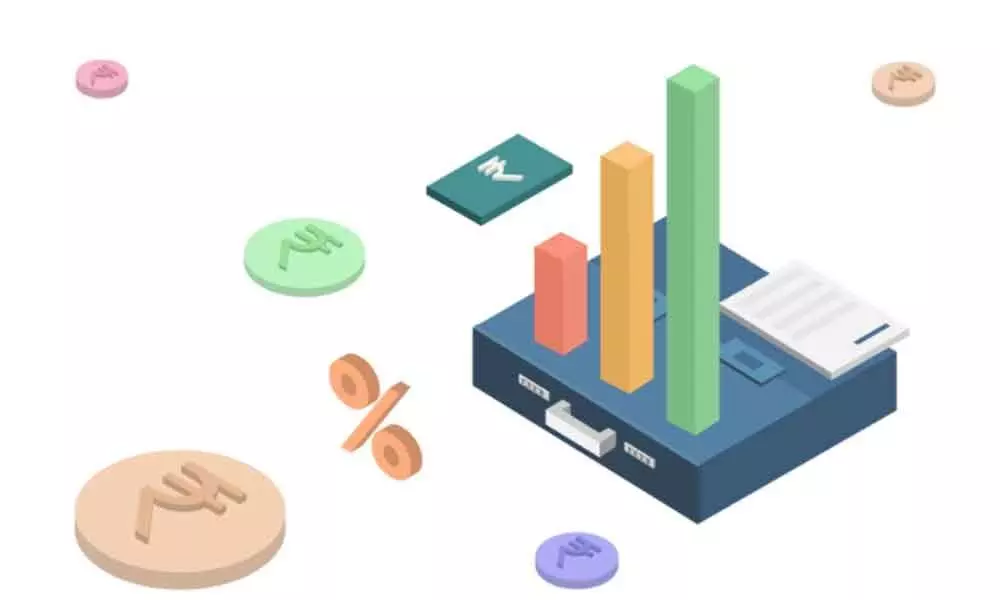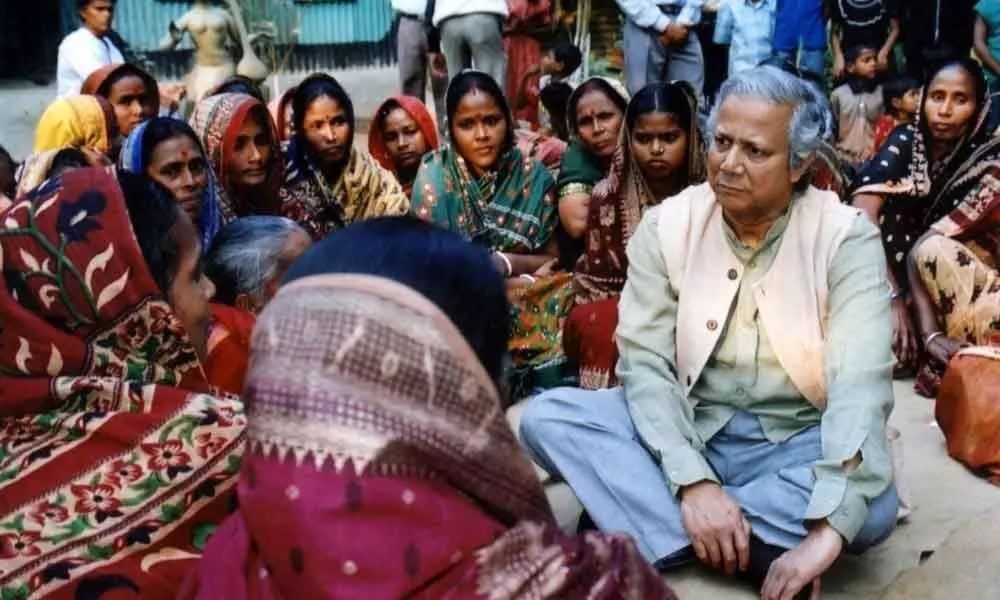Live
- Six Accused in Attack on Allu Arjun's House Granted Bail by Magistrate
- Lakshmi Manchu emp hasises the importance of mental and physical health
- Telangana CM Condemns Attack on Allu Arjun's House; Strict Police Action Ordered
- Bail Granted to Six Accused in Allu Arjun Residence Attack Case
- Chief Minister Revanth Reddy Extends Best Wishes on Singareni Foundation Day
- Sukumar Hails Ram Charan's "National Award-Worthy" Performance in Shankar's 'Game Changer'
- CM Revanth Reddy to Hold Review Meeting with Senior Officials Today
- Pawan Kalyan's Visit to Penamaluru Constituency Today
- Kadapa Municipal Corporation Meeting: Heavy Police Deployment and Section 144 Imposed
- Mandhana, Renuka blow away Windies in first ODI
Just In
Muhammad Yunus, founder of the world-famous Grameen Bank, often describes the poor as natural entrepreneurs. Combined with the late business guru C.
K. Prahalad's exhortation to businessmen to focus more on what he called the "bottom of the pyramid," the idea of the entrepreneurial poor is helping to secure a space within the overall anti-poverty policy discourse where big business and high finance feel comfortable getting involved. The traditional strategies of public action are being supplemented by private actions, often taken by some of the leaders of the corporate world (for example, Pierre Omidyar of eBay), directed at helping the poor realize their true potential as entrepreneurs.
The basic premise of Yunus's view of the world, shared by many in the microfinance movement, is that everyone has a shot at being a successful entrepreneur. More specifically, there are two distinct reasons the poor may be particularly likely to find amazing opportunities. First, they haven't been given a chance, so their ideas are probably fresher and less likely to have been tried already. Second, the market so far has mostly ignored the bottom of the pyramid. As a result, it is argued, innovations that better the lives of the poor have to be the low-hanging fruit, and who better than the poor themselves to think of what they could be?
Indeed, every self-respecting MFI has a website with a number of stories of successful microfinance clients who took advantage of an unusual opportunity to make a fortune. They are real: We have met several of those clients.
In Guntur, in Andhra Pradesh, we met a client of Spandana who had built a very successful business collecting trash and sorting it. She started as a trash collector, which is pretty much as low as you can go in the Indian social and economic hierarchy. With her first loan from Spandana, she just paid back the loan she had from a moneylender, with its crippling interest rate. She knew that the businesses that bought the trash from her sorted it before selling it to recyclers—there would be bits of metal and tungsten from the filaments of used lightbulbs, plastics, organic matter for composting, and so forth, each of which went to a different recycler. With the breathing space that the first loan bought her, she decided to do the sorting herself to make some extra money. With her second loan and the savings from the first, she bought a cart, which helped her collect more trash, and because there was now more sorting to be done, she somehow managed to get her husband, who used to spend most of his time drinking, to start working with her. Together they were making significantly more money, and after receiving the third loan, they started buying trash from others. By the time we met her, she was at the helm of a large network of trash collectors, no longer a collector herself but an organizer of trash collection. Her husband, too, was working full-time by then: We saw him pounding away on a piece of metal, looking sober but a trifle glum.
MFIs advertise the stories of their most successful borrowers, but there are also entrepreneurs who succeed even when they have no access to microfinance. In 1982, Xu Aihua was one of the best middle-school students in her village, in the Shaoxing region of Zhejiang Province in China. Her parents were peasants and, like almost everyone else, had very little disposable cash. She was so bright, however, that the village decided to send her for a year to the local school of fashion design (whatever that meant, exactly, since everyone still wore Mao suits). The idea was that she would eventually take a leadership role in the local town and village enterprise that had just been set up (these were the early years of Chinese liberalization). But when she came back after her training, the local elders got cold feet—she was a girl, after all, not yet twenty. So, she was sent unceremoniously home, jobless.
Xu Aihua had no intention of sitting idle. She decided that she had to do something, but her parents were too poor to help. So, she borrowed a megaphone and went around the village offering to teach young girls how to make garments for a fee of 15 yuan ($13 USD PPP). She recruited 100 students, and with the money that she had just collected, she bought a secondhand sewing machine and some surplus fabric from the local state-owned factories, and started teaching. At the end of the course, she kept her eight best students and launched a business. The women would arrive every morning with their sewing machines on their back (they each got their parents to buy them one), then start cutting and sewing. They made uniforms for the local factory workers. At first they worked at Xu Aihua's home, but as the business expanded and Xu Aihua trained and hired more people, they moved to a building that she rented from the village government.
By 1991, she had saved so much from the profits of her business that she could afford to buy sixty automatic sewing machines for 54,000 yuan ($27,600 USD PPP). Her total fixed capital had grown more than a hundredfold in eight years. That is 80 percent per year. Even if we allow for an inflation rate of 10 percent per year, a real growth rate, net of inflation, of more than 70 percent a year is impressive. By this time, she was an established entrepreneur. Export contracts arrived soon after, and she now sells to Macy's, Benetton, JC Penney, and other major retailers. In 2008, she made her first investment in real estate of 20 million yuan ($4.4 million USD), because, as she says, she had some cash sitting around, and most other people did not.
Xu Aihua is not a typical case, of course: She was especially bright, and her village sent her to school. However, there is no dearth of success stories of entrepreneurship among the poor. And there is certainly no shortage of entrepreneurs. On average in our eighteen-country data set, 50 percent of the extremely poor in urban areas (those who live on under 99 cents a day) operate a nonagricultural business. Even among the rural extremely poor, many—from 7 percent in Udaipur to up to 50 percent in Ecuador (and 20 percent on average)—operate a non-agricultural business, in addition to the large number who run a farm. The number of entrepreneurs is roughly the same among the somewhat less poor in the same countries.
Compare this to the Organization for Economic Co-operation and Development (OECD) average: 12 percent of those in the workforce describe themselves as self-employed. Purely in terms of stated occupations, most income groups in poor countries seem to be more entrepreneurial than their counterparts in the developed world—the poor no less so than others, an observation that inspired Harvard Business School professor Tarun Khanna's book, Billions of Entrepreneurs.
- Extracted with permission from Penguin Random House India from the book 'Poor Economics: rethinking poverty & the ways to end it' by Abhijit Banerjee and Esther Duflo

© 2024 Hyderabad Media House Limited/The Hans India. All rights reserved. Powered by hocalwire.com











